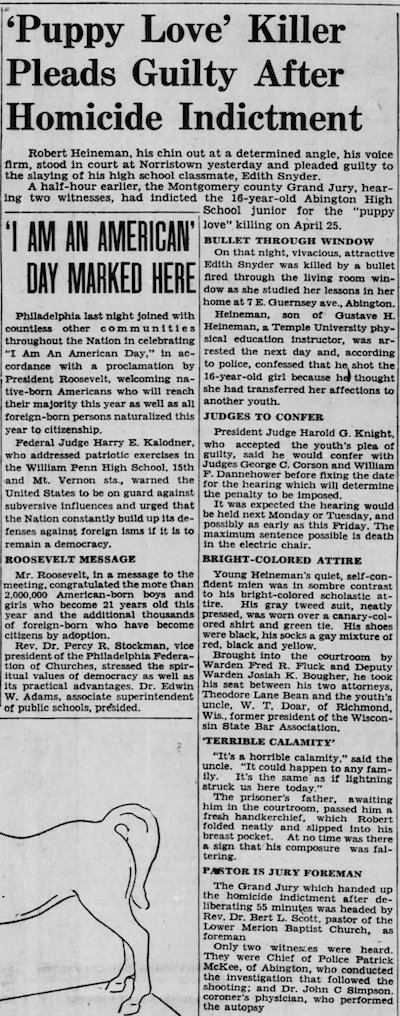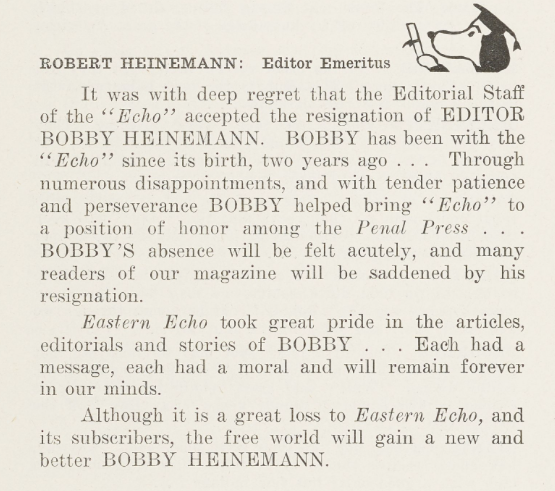Established 2023
A Society Within a Society - The Life of Robert Heinemann
Monday, November 4, 2024
Kate Swett
A New Name: D-4943


On April 25, 1940, Robert Heinemann fatally shot Edith Snyder, a fellow 16 year old and classmate. Robert Heinemann was the son of a Temple University professor living in Philadelphia. He confessed to the crime of shooting Edith through the front window, claiming his jealousy had gotten the better of him after suspecting she had feelings for somebody else. However, District Attorney Frederick Smillie reported that the psychiatrist deemed Robert close to insanity unless “his mental habits are controlled.” The Philadelphia Inquirer (on the left) describes Robert’s crime as “‘Puppy Love’ Killer”, portraying Edith’s murder as the product of young love. With other striking headlines covering the page, from “Bullet Through Window” to “Terrible Calamity”, the paper seeks to create a vibrant story for its viewers. Even the description of Edith as vivacious and attractive calls for a narrative that Robert was merely a lovestruck boy who made a spontaneous decision to kill. The description of his bright attire draws attention to Robert’s young age and immatureness, alluding to his humanness and susceptibility to mistakes. Robert, at only 16, had found himself at the hands of the law in a time where his emotions and hormones were rapidly changing, causing him to act irrationally. Robert’s statement was that he and Edith had planned to die together but his suicide plans hadn’t worked out. While his actions and reasonings may seem unreasonable to many, Robert’s horrifying actions did not define him as a whole person. He was found guilty of first-degree murder and sent to the Eastern State Penitentiary at inmate D-4943. His life and work here would prove Robert to be a man capable of change and growth as a person and member of society.
Fulfillment Within Eastern State Penitentiary's Walls

Robert soon found himself a life within Eastern State Penitentiary as the editor in chief of the Eastern Echo from 1956-1957. Having been sentenced to life in prison at just 16, Robert developed his interests and life as an adult within the prison community. With a gift for writing, the inmates of ESP alongside Philadelphia citizens found joy and comfort in Robert's issues. Within ESP, there were many smaller communities, from the Eastern Echo family to the avid members of the chess club, a society emerged as the inmates lived amongst each other. Robert, often referred to as "Bobby" by his fellow inmates, found purpose in many forms that portrayed his true self apart from his crimes.

One of Robert’s ongoing columns within Eastern Echo included “Cage One”, editorials discussing his views on the justice system and prison reform. He was passionate in speaking out about ways to ensure prisons were institutions where criminals came to truly change their ways and prevent future crimes. In the Winter 1957 edition, his Cage One editorial mentioned, “Your efforts, combined with theirs, can make all prisons corrective-minded, and all crime prevention truly preventive.” Similarly, he often wrote about the ironic injustice in prison design focusing on isolation which would later lead to troubles rejoining society. As an inmate facing life in prison, Robert’s insightful perspectives reflected actual inmates’ opinions and desires, and he sought ways to find change through writing. Apart from his crimes, Robert sought to instill community and humanness into the lives of his fellow prisoners. Following his own ideals that prisoners should be treated as valuable members of society, he used his time as editor in chief to make prison life a little more ‘normal’ and joyous.


An excerpt from an interview column shows Robert’s perspective on life sentences. He answers that 12 years should be the max sentencing for prison, for after that one’s personality deteriorates. This deterioration in personality stems from prisoners losing hope in themselves and in society, becoming a shell of their former selves. He believed that the prison system had increased sentences as a solution to ineffectiveness in prison sentences reforming prisoners. However, he combatted this decision by expressing that an increase in prison time does nothing to deter crime but rather what the prison chooses to teach and provide during this time is what really matters. Robert wanted to find ways to “help men help themselves” by taking true interest in prisoners, understanding their troubles, and working to reverse these issues. His unwavering support for better prison reform practices in the 1950s is an inspiring foreshadowing to the countless debates on America’s highly criticized modern incarceration systems. While most prisons still prioritize sentence lengths, more modern prisons in Norway have adopted this method of treating the prisoners as humans, providing amenities (like TVs and libraries) and preparing them to reenter society. Norway’s crime relapse rate is incredibly low, proving Robert’s beliefs to effective and inspiring.

“Happiness Is Just a Dog Called Snoopy” was another one of Robert’s hit columns for the Eastern Echo. Using the well-loved cartoon Snoopy as the face for the column, the Peanuts dog charmingly shared recent prison news. It’s clear Robert had a good sense of humor and wanted to bring joy to his fellow inmates through his column to get through times of hopelessness. While his violent past clings on, Robert’s personality and innate skills for writing shines through Eastern Echo’s words and designs.

As his time with the Echo came to an end, his great impact is displayed through the gratitude and admiration of his peers. It is clear Robert was respected as a man and member of the Eastern State community. He is described to spreading messages of moral through his editorial work, highlighting his great work ethic. Bobby’s attention to detail and pure passion for his articles and the overall cohesion of the Echo is what allowed it to inspire others, in and out of the prison walls.
A Musical Outlet

Robert Heinemann found further community in the Eastern State Penitentiary’s lively band. As second trombone, Robert even received honorable mentions for his dedication to the band’s performances. The photo below depicts the Eastern State’s band during a Christmas broadcast a few years prior to Robert’s conviction. This is likely similar to performances Robert would’ve been a part of, playing alongside his fellow inmates for his prison community. In a place so secluded from the human world, Robert and many others found ‘humanness’, a society and purpose, within the otherwise gloomy penitentiary.

A Moral Dilemma

As Robert Heinemann’s life within the penitentiary has shown his creative outlets and integration into a new community, one must not forget the impact of his past. Robert has proved it possible to find joy and life within imprisonment, gaining the respect of others through his work with the Eastern Echo. Shown on the left are over 10 messages left for Robert, from both prisoners and civilians, that document the positive impact Eastern Echo has had on countless individuals. For example, “Dear Bob: All my Penal Press friends are watching EASTERN ECHO with cheers.” This is just one of many words of admiration for Robert’s impact within the prison, a new life he was able to make the best of. However, while this great adaptation to prison life is admirable, one must grapple with the thought that Robert has also afforded these experiences at the expense of a young girl’s life. While his work spread joy in dark times, the world will never get to know Edith Snyder as an adult or what she had to contribute to our society. This account of Robert’s life in the Eastern State Penitentiary is a prime example of how prisons didn’t house emotionless robots, they were also communities and mini societies for those needing time to reconcile. An individual can be HUMAN and have meaningful experiences even while secluded from society with the burden of their crimes weighing upon them.
Works Cited
Cuff, Joseph. “Happiness is Just a Dog Called Snoopy.” Eastern Echo, Mar. 1958.
Culp, Jerry, editor. “The Eastern Echo Asks.” Eastern Echo, Mar. 1956.
Culp, Jerry. “Themes and Variations.” Eastern Echo, Mar. 1956.
Heinemann, Robert, editor. “The Eastern Echo Mail Bag.” Eastern Echo, Dec. 1957.
Heinemann, Robert. “Happiness is Just a Dog Called Snoopy.” Eastern Echo, Mar. 1957.
Heinemann, Robert, editor. “Staff Members of the Eastern Echo.” Eastern Echo, Mar. 1957.
Heinemann, Robert. “Cage One.” Eastern Echo, Mar. 1957.
Kerr, Barbara. Photo of Edith Snyder. 2021. Find a Grave, https://www.findagrave.com/memorial/145562233/edith_isabella-snyder. Accessed 2024.
"Newspaper account of murder" Newspapers.com, The Philadelphia Inquirer, May 21, 1940, https://www.newspapers.com/article/the-philadelphia-inquirer-newspaper-acco/9050345/
